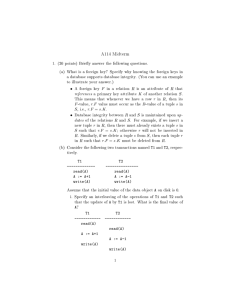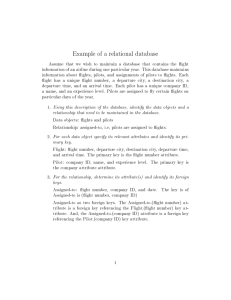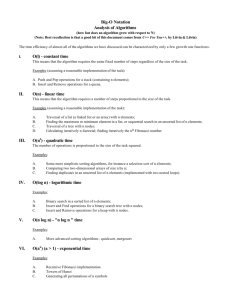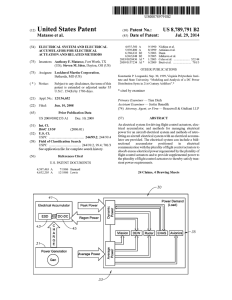TDDB 57 Data
advertisement
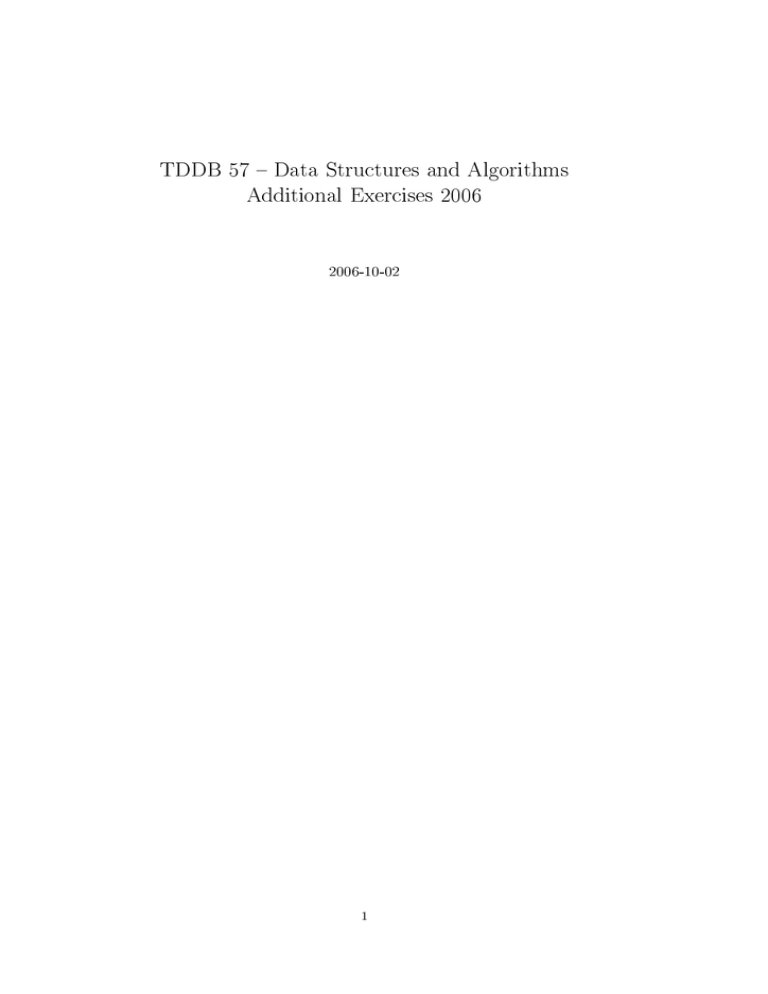
TDDB 57 Data Structures and Algorithms Additional Exercises 2006 2006-10-02 1 Le 6 Graph Algorithms and Algorithmic Paradigms 1. Draw a connected, undirected, weighted graph with 8 vertices and 16 edges, each with unique edge weights. Illustrate the execution of Kruskal's algorithm on this graph. Identify one vertex as a start vertex and illustrate the execution of Dijkstra's algorithm on this graph. 2. John is an exchange student in city L . He wants to go for an excursion but he can only pay at most 200 in local currency for the ticket. The following graph shows the excursion ticket prices between some destinations that may be interesting for John. The cost of excursion along an arbitrary path in the graph is the sum of the edge costs. 160 A F 120 50 20 E 200 C 30 70 50 100 L 160 D B 60 60 (a) Give the idea of an algorithm that would nd all destinations that John can aord. (b) Illustrate the operation of the algorithm on the example graph; show the cost for each aordable destination. 3. Members of the yacht club have their summer houses at six neighbouring islands in St. Anna archipelago. The distances between the islands are so small that they can be connected by bridges. The cost of a bridge depends on the distance. The distances in meters are given in the table: I1 I2 I3 I4 I5 I6 52 28 26 25 43 75 26 50 81 21 10 5 15 95 I2 I3 I4 I5 12 Decide which bridges are to be built to connect all islands at minimum cost. Justify your decision and show step by step how it was computed. 4. Outline an algorithm that for a given vertex v of a weighted DAG G with n verices and m edges computes the length of the shortest path from v to every vertex of G in time ( + ). O m n 5. The timetable of daily ights shows the direct non-stop ights between some of the airports A, B, C and D, e.g. A to B: 8.30, 12.30, 18.30 B to A: 6.30, 10.30, 15.15 Duration of each ight 1 hour 15 min. 2 A to C: 10.15, 17.30 C to A: 8.30, 15.15 Duration of each ight 1h 45 min. B to C: 11.15, 13.25, 18.00 C to B: 9.30, 12.50, 16.15 Duration of each ight 45 min. B to D: 11.15, 14.25, 18.00 D to B: 9.30, 16.15, 20.30 Duration of each ight 1 hour 10 min. C to D: 11.15, 18.00 D to C: 9.30, 16.15 Duration of each ight 50 min. A connecting ight at any of the airports can be booked not earlier than 45 min after the arrival. For given airports X and Y we want to nd a ight connection that leaves X at earliest at time t and arrives Y as early as possible. (a) Formulate the problem as a graph problem. Which of the known graph algorithms can be modied to solve it? Justify your answer and discuss the modications needed. (b) Illustrate the steps of the proposed algorithm for the example timetable for a trip from A to D with departure at earliest at 10.00. (c) Discuss the complexity of your algorithm. 6. An n-degree polynomial is an expression of the form 0+ 1 + + are constants 6= 0 and is a variable ranging over real numbers. a 0 where a ; : : : ; an a x an ::: n an x x (a) Analyze the time complexity of computing the value of this expression following its form, under the assumption that x i is not a primitive operation but has to be computed by multiplication. (b) Outline another algorithm that under the same assumption computes the value of a polynomial of degree n in time ( ). n Can you link this solution to one of the algorithm paradigms discussed in the course? 7. Explain the principles of greedy method and justify why Human's algorithm for building optimal encodings is a greedy algorithm. What are other examples of greedy algorithms discussed in this course? 8. Draw the frequency array and Human tree for the following string dogs do not spot hot pots or cats Show the encoding of the string post stop. 9. Explain what is the principle underlying the longest common subsequence algorithm. XZACKDFWG and ABCDEEFG. What is the longest common subsequence of these strings. Construct the longest common subsequence array for the strings 10. Consider the usual denition of Fibonacci numbers: F (0) = 0 ; F (1) = 1 ; ( )= ( F n F n 1) + ( F n 2). Analyze the time complexity of a recursive procedure using this denition for computing Fibonacci numbers. Design an algorithm for computing Fibonacci numbers based on the dynamic programming principle and analyze its time complexity. 3 11. Consider the following pseudocode describing a procedure f oo referring to an auxilairy procedure bar . procedure f oo(array if l < r then m [ ]) a l::r (+ )2 [ ]) ( [ + 1 ]) ( [ ], [ + 1 ]) l r = f oo(a l::m f oo a m ::r bar a l::m a m ::r (a) Which algorithm paradigm is represented by this procedure? (b) Which of the algorithms discussed in the course has the same structure as this procedure. 1 rows of integers from = 1 . Thus, an input data can be seen as a triangle, as illustrated below for = 4. 12. Consider the following problem. The input data consists of n the interval [ ]. The maxint; maxint i-th row has i elements, for i ; :::; n n 41 x ; A 31 x ; 11 x ; 21 x ; 22 x ; 32 x ; 42 43 x ; x ; 33 x ; 44 x ; path in such a triangle is a sequence of numbers obtained by starting at the top and choosing at every step one of the two closest elements in the next row until the last row is reached. More precisely, it is a sequence of n numbers that starts with x +1 such that each of its elements xi;j is followed by the element xi +1 +1 , for i = 1; :::; n 1. end with the number x4 2 : xi ;j ; ;j 11 ; and or by the element For the example above, the following are the pathes that 11 21 31 42 11 21 32 42 x1 1 ; x2 2 ; x3 2 ; x4 2 x ; ;x ; ;x ; ;x ; x ; ;x ; ;x ; ;x ; ; A ; ; ; cost of a path is the sum of its elements. The problem is to nd the cost of the most expensive path in a triangle of size n. (a) Construct a recursive algorithm that solves the problem by starting at the top of the triangle. Analyze the time complexity of this algorithm (upper bound and lower bound). (b) Construct another algorithm that solves the problem in ( ). n (c) Which are the underlying algorithm paradigms of these algorithms? 4



